2015 – the return of £150/T?
Posted by Anderson Grain Marketing on Dec 16, 2014 in AGM News | 0 comments
By early October 2014, 16.60M/T of wheat had been harvested here in the UK – one of the largest wheat crops on record. Idyllic drilling conditions back in autumn 2013, a mild winter followed by a warm spring and ‘adequate moisture throughout’ had produced a wheat crop which averaged almost 3.5 tonnes to the acre.
16.6M/T also represents a 38% increase on 2013’s production and is the largest rebound in production ever recorded.
Wider Europe also had an excellent wheat harvest this year and although quality issues remain for some countries (namely France and Germany), the majority have seen a large rebound in production.
155.00M/T of wheat is believed to have been harvested throughout the European Union – a 13.00M/T increase on last year.
As we head into 2015, I think it’s safe to say that physical wheat supplies are, to lend a quote from the HGCA ‘widely available in abundance’; crops throughout the Northern Hemisphere have performed extremely well and whilst speculation remains regarding the impending Southern Hemisphere crops, the majority look to be on track for at least above average production.
Consequently, it is hardly surprising that wheat values slumped to £105/T ex-farm at harvest time this year. Feed wheat for collection off the combine in August 2014 was initially valued at £160.00/T ex-farm as the crop entered the ground last year and as the crop itself advanced throughout the various growth stages with minor problems; its off the combine value retreated.
Comparatively small volumes of the crop were sold forward at these levels although many were pushed into a sale at £150/T ex-farm in the spring – something which we later received thanks for!
Over the last three years the UK wheat market has been underpinned with such volatility that it makes it difficult to judge when a sale should be made; I have worked for Anderson Grain for almost four years now and I have seen feed wheat values top £235/T ex-farm and slump to £100/T ex-farm.
But what should we expect as we head into 2015?
Physical grain supply clearly isn’t a problem at the minute and if the Southern Hemisphere harvests go to plan, it shouldn’t be until at least the approach of the 2015 Northern Hemisphere harvest.
However, as always, there are a number of ‘if’s and but’s’ which could potentially undermine the above fundamentals and change the long term outlook as we head into the New Year.
Politics, weather and wider economics can all have as much of an impact on local ex-farm values as physical supply and demand.
Will Russia impose an export ban on grain? Will the recent wet weather in South America damage crops there? Will the Euro strengthen or weaken against the US dollar? How much export potential will Europe have if it strengthens? Will a cold winter damage the developing US winter crops?
The answers to the questions above will all play a significant part in the direction of grain values throughout early 2015. The problem is politics, weather and wider economics make everybody’s crystal ball cloudy; all we can do is judge the information given on any one day.
Information is key; tracking these events as they play out throughout the course of next year will at least give you the ability to make an informed decision, whether the market heads up or not.
Merry Christmas to all of our readers and here’s to a prosperous New Year. Maybe 2015 will bring the return of £150.00/T? Fingers crossed.
